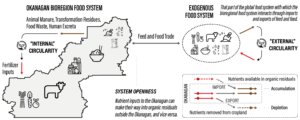The concept of “circular biobased economy” has become an important pillar of a new generation of policies that are expected to solve the current sustainability crisis. Moving towards a circular biobased economy crucially depends on biological and technical processes capable of recirculating plant nutrients – from used biobased products back to the production of food, feed, fibre, fuel, and so forth.
Nutrient flow analyses can help identify drivers of unsustainable patterns and opportunities for moving towards more sustainable patterns. As part of a broader food system design project in the Okanagan Bioregion, BC Canada, we analysed the flows of nitrogen, phosphorus, potassium, and magnesium to help stakeholders in the bioregion better understand current levels of nutrient circularity and how it could be improved.

When assessing the level of nutrient circularity for a bioregion like the Okanagan, simply comparing crop nutrient need and nutrients available in organic residuals may give a distorted picture because nutrient inputs to crop production in one place may make their way into organic residuals in another place. Therefore, our analysis went beyond crop nutrient need and nutrients in organic residuals in the bioregion exclusively. Insofar as nutrient flows relate to food consumption (much of which is imported) and production (much of which is exported) in the bioregion, the analysis also included crop nutrient need and nutrients in organic residuals outside the bioregion. This approach enabled a separate discussion of internal and external nutrient circularity.
The Okanagan study is presented in a suite of three papers. The first paper (Harder et al. 2021a) describes in detail the conceptual framework and explains how it adds to previous work. The second paper (Harder et al. 2021b) outlines the calculation model for the Okanagan and discusses nutrient circularity for the baseline year 2016. The third paper (Harder et al. 2021c) discusses nutrient circularity for four food system scenarios for the year 2050.
The analysis clearly revealed that the quantity of nutrients in organic residuals in the Okanagan is higher than crop nutrient need. At first sight, this suggest that comprehensive nutrient recovery may not be needed in the bioregion. But the large amount of nutrients in organic residuals in the bioregion is due to system openness associated with feed and food trade. In other words, the increased nutrient self-reliance internal to the bioregion comes at the expense of a reduced nutrient self-reliance external to the bioregion. Provided that the goal of nutrient management is to maximize nutrient circularity, across all scenarios, it will be necessary to re-distribute nutrients both within and across the spatial boundaries of the Okanagan. This will become even more important in 2050, mainly due to the projected population increase and the possibility for increased local livestock production and thus more feed imports.
Scientific Papers:
Harder R, Giampietro M, Smukler S (2021a). Towards a circular nutrient economy. A novel way to analyze the circularity of nutrient flows in food systems. Resources, Conservation & Recycling. DOI: 10.1016/j.resconrec.2021.105693.
Harder R, Giampietro M, Mullinix K, Smukler S (2021b). Assessing the circularity of nutrient flows related to the food system in the Okanagan bioregion, BC Canada. Resources, Conservation & Recycling. DOI: 10.1016/j.resconrec.2021.105842.
Harder R, Mullinix K, Smukler S (2021c). Assessing the circularity of nutrient flows across nested scales for four food system scenarios in the Okanagan bioregion, BC Canada. Frontiers in Sustainable Food Systems. DOI: 10.3389/fsufs.2021.661870.
Research Brief:
Harder R, Mullinix K, Smukler S (2021). Nutrient Management in the Okanagan Bioregion. Institute for Sustainable Food Systems, Kwantlen Polytechnic University, Richmond, BC. Download report here.
Background Information:
Find out more about the Bioregion Food System Project here.
